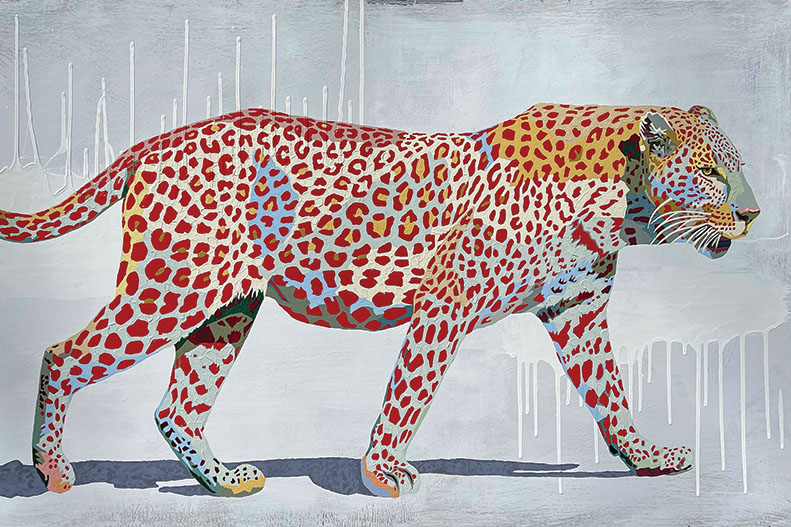
My paintings are not at all simple from a technical perspective, but their essence and stark compositions are,” painter Annie Hooker told Western Art Collector Magazine in 2020. “I feel that is still true for my work,” she says now. “I tend to focus very intensely on one subject with a non-competitive background. That makes the subject stand out without a lot of noise.” Indeed, at first glance Hooker’s work appears uncomplicated. Closer examination reveals the level of attention to small details that creates that illusion of simplicity.
A native San Franciscan who now makes her home in Auburn, as the great-granddaughter of Pebble Beach founder S.F.B. Morse, Hooker has deep Monterey Peninsula roots. Morse was also a painter, and perhaps that DNA at least partially informed her career choice. “I know that he loved painting, loved art and associated with a lot of artists,” she says. “It was a gentlemanly interest for him, an intelligent and admirable activity.”
Hooker’s talent shone through at an early age. “I can trace my passion for art to kindergarten,” she recalls. “As insignificant as this may seem, I have a clear memory of a teacher being genuinely interested and excited about my drawings and it stuck with me. I remember that amazing feeling of being recognized.” Being a child of divorced parents, Hooker remembers taking her art supplies and drawings back and forth with her between parents’ homes, like a constant companion. “As a young kid I remember coming home from an outing with my father and attempting to draw faces I had seen that day from memory.” Showing promise in high school, she went on to attend California College of Arts and Crafts (now California College of the Arts) in Oakland. “I was committed to being a painter. Every job I had—grocery store stocker, nanny, teacher’s assistant—was a means to support my art.” It was a struggle at first, but that dedication has paid off. “Painting has been the north star of my life. I will never retire, and hope that I’ll be doing my best work in my 70s.”
Her process is unrushed. She begins by photographing her subject, and that’s where her attention to fine detail begins. For instance, for her “Cowboys” series, Hooker rented props and outfits from a Los Angeles film costumer, hired models and shot them at area ranches. She keeps a monitor next to her easel, using the images as a roadmap. “The photo shows me generally where to go,” she says.
For her current series of Cypress trees, Hooker was able to utilize her familial heritage, gaining access to the Cypress Point Club grounds at Pebble Beach to photograph those dramatic trees. “They have the most mind-bending trees. Some are so wind-blown, gnarled and old. They’re by far the most dramatic trees that I’ve seen on the coast—ancient, connected and strong.” Driving around the property in a golf cart, “I felt a connectedness to the location. My ancestors walked these grounds, and I felt their presence.”
There is nothing rushed about Hooker’s technique. “From design to execution, each painting can take three weeks, sometimes more,” she says. She is extremely self-disciplined. “I don’t paint just when I feel like it. I paint every day. Six days no matter what, but seven is my preference. I learned early on how to easily get in the work mode.” Even a strong work ethic doesn’t ensure that every painting is an instant masterpiece: “They don’t come out great every time. They go through processes. You can decide to throw it away, or you can dance with it and massage it until you get it right,” she explains. “And then, there are magical times when everything goes perfectly right.”
Hooker’s paintings are bold expressions, drawing the viewer in and demanding attention, quite different from the artist herself. “I have an introverted personality,” she explains, “but I want my paintings to be extroverted. I use them to be a louder voice.” Part of what sets the subjects front and center is her choice of setting them against simple, yet finely rendered backgrounds. “I like patterning. Because my subjects are so isolated, all the patterns mean something to me.” Her cowboy (and cowgirl) paintings are set on what appears to be sheets of three-ring notebook paper. “Notebook paper is nostalgic. First, I liked it as a design element, then I realized it was impactful to the viewer. They touch people in profound ways, evoking childhood memories.”
Annie Hooker is represented in Carmel by Gallery Mar, where she will be having a show opening September 23rd with artists Matthew Sievers and Jeffery Pugh.
For more info visit www.gallerymarcarmel.com and www.anniehooker.com.